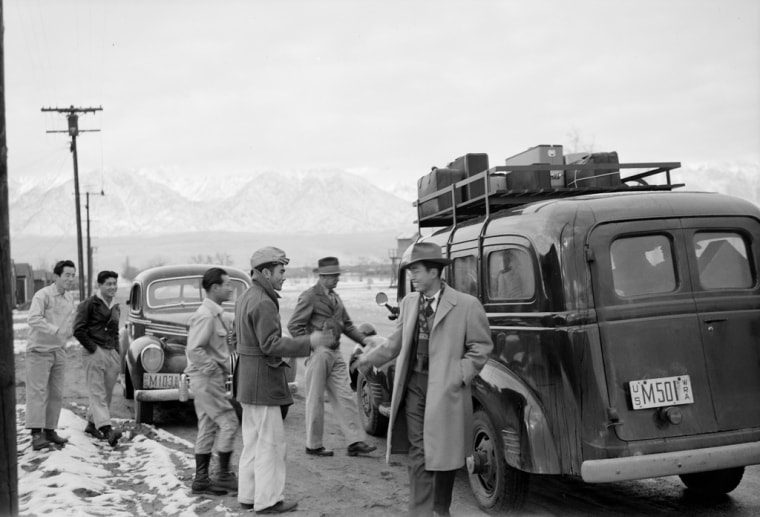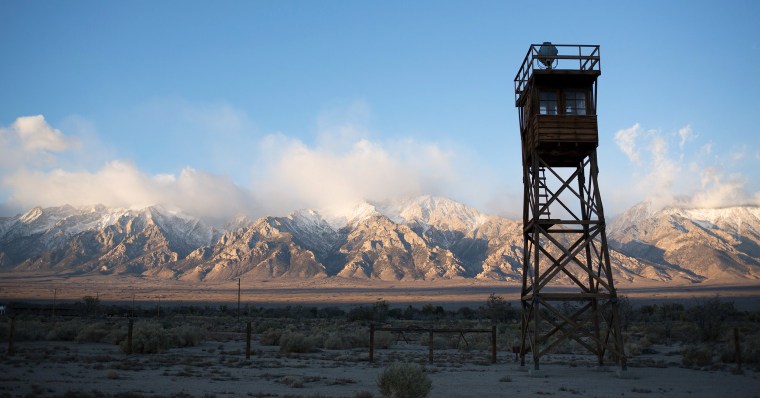When Jeelanne Khattab learned about Manzanar for the first time this year, she immediately knew that she needed to visit the site where more than 10,000 Japanese Americans were incarcerated during World War II.
“Even as a teacher I didn’t know about this place and the suffering that Japanese Americans had to go through,” Khattab told NBC News. “I had to see it with my own eyes. It’s about time that we learned about this history.”
“At this moment in history, we really need a deeper solidarity with each other. The American Muslim community, specifically, has a lot to learn from the struggles of other marginalized communities."
Khattab, a teacher from the Southern California city of Rancho Cucamonga, was among a group of about 150 California Muslims who on April 29 traveled to Manzanar, one of the 10 incarceration camps that held more than 120,000 Japanese Americans during World War II.
Now a National Historic Site, Manzanar, located about four hours outside of Los Angeles, has become the home to an annual pilgrimage, which remembers the incarceration with musical performances, speeches by survivors and Japanese-American activists, and an interfaith prayer service.
Since the Sept. 11, 2001, attacks, a growing number of Muslim Americans started joining in the pilgrimage as an act of solidarity and to draw parallels between the past treatment of Japanese Americans and the present threat to the civil liberties of Muslims, according to the Council on American-Islamic Relations (CAIR).

This year, the 75th anniversary of Executive Order 9066, which paved the way for the creation of the incarceration camps, attendees said those comparisons have become even more palpable.
“Unless we as Americans act quickly together and speak up, we might face an injustice that is equivalent to what the Japanese-American community faced 75 years ago,” Hussam Ayloush, executive director of the Greater Los Angeles chapter of CAIR, told NBC News.
RELATED: Seventy Years After Manzanar, the Stories of Incarceration Live On
The circumstances that led to the concentration camps also exist today, he noted.
According to a 1980s federal commission, there were three causes of Japanese-American imprisonment: “race prejudice, war hysteria and a failure of political leadership.”
“That formula created the perfect storm that allowed this grave injustice to happen,” said Ayloush. “Now we’re living through the same pattern.”
“Unless we as Americans act quickly together and speak up, we might face an injustice that is equivalent to what the Japanese-American community faced 75 years ago.”
“There’s a growing Islamophobia in America that perceives Muslims as the threat, as the other, as the enemy,” he added. “…And we have President Trump who has used fear-mongering during the campaign and after the campaign, talking about banning Muslims, talking about registering American Muslims, talking about Islam hates America.”
There is also a similarity between the two executive orders — 9066 and President Donald Trump’s immigration ban from six predominately-Muslim countries — he said.
Bruce Embrey, co-chair of the Manzanar Committee, which has sponsored the pilgrimage for more than four decades, agreed.
RELATED: When Japanese Americans Were Caged: 75 Years After Executive Order 9066
“The parallels couldn’t be any clearer,” Embrey told NBC News. “It’s eerie. The language and the terminology that those who are attacking the Muslim community are using — you could just transpose ‘Japanese’ with ‘Muslim’ and it would be similar to what our parents and grandparents were subjected to.”
“This country has never really come to grips with its past on any level,” he added.
One corrective is events like the Manzanar Pilgrimage, which educates and empowers Muslim Americans by connecting them to Japanese-American activists and survivors of the incarceration camps, Ayloush said. For over a decade CAIR has organized charter buses to take groups of California Muslims to the pilgrimage.
“We engage with them — why are you here, what are you hoping to achieve by coming, how does this relate to your own struggles today?” said Ayloush. “We wanted to instill in them not desperation, not victimization, but exactly the opposite — empowerment, hope and a commitment to working with others for justice for all people, not just themselves.”
Aliyah Shaikh, an undergraduate at California State University, Long Beach, said that attending the Manzanar Pilgrimage was an opportunity for Muslims to build coalitions.
“At this moment in history, we really need a deeper solidarity with each other,” she told NBC News. “The American Muslim community, specifically, has a lot to learn from the struggles of other marginalized communities. Rather than thinking of our specific experience in the United States as different, instead of trying to get mainstream approval, it’s time to learn from other liberation struggles.”
Follow NBC Asian America on Facebook, Twitter, Instagram and Tumblr.
Correction: An earlier version of this story misstated the year of the Sept. 11, 2001, terrorist attack.
